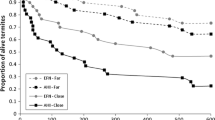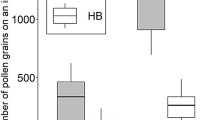Abstract
In a one-year study, the production of honeydew in hedges of Upper Frankonia and its utilization by food-searching insects were investigated. The phloemfeeding fauna and its seasonal development on hedgeshrubs were assessed by means of the ‘beating method’.
Out of the 25 sap-sucking species recorded on the shrubs typical for hedges, the Psyllidae on hawthorn (Crataegus spec.) and the Aphididae on blackthorn (Prunus spinosa) were most abundant during the period of investigation producing considerable amounts of honeydew.
On most hedgeplants honeydew production reached a maximum in spring with a sharp decline in summer and a second but smaller peak in autumn. In contrast, the development of the aphids on blackthorn and oak persisted throughout the summer and therefore there was a continous honeydew supply for foodsearching insect species in the hedges during the season.
On blackthorn a total of 139 insect species were recorded taking up honeydew from the plant's surface. In species number as well as in individual number the syrphids were the most frequent honeydew visitors. EspeciallyEpisyrphus balteatus (Deg.) was observed to feed in great numbers on the excretions of aphids.
Zusammenfassung
Im Rahmen einer einjährigen Arbeit wurde die Produktion von Honigtau in oberfränkischen Hecken und dessen Nutzung durch die Arthropodenfauna untersucht. Dazu wurde das Artenpektrum und die Phänologie der phloemsaugenden Insekten mit Hilfe der ‚Klopfprobemethode’ über die gesamte Vegetationsperiode hinweg erfaßt.
Von den 25 an den heckentypischen Gehölzarten festgestellten Phloemsaugern traten die Psylliden an Weißdorn und die Aphididen an Schlehe in besonders großen Individuenzahlen auf. Sie stellten im Untersuchungszeitraum die ergiebigsten Honigtauproduzenten in den bearbeiteten Hecken.
Die Honigtauabgabe erreichte an den meisten Heckengehölzen ihr Maximum im Frühjahr, mit einem Abklingen in den Sommermonaten und einem erneuten kleineren Anstieg im Herbst. Demgegenüber dauerte die Blattlausentwicklung an der Schlehe und der Eiche den Sommer über an und ermöglichte so ein kontinuierliches Honigtauangebot für nahrungssuchende Insekten über die ganze Vegetationsperiode.
An der Schlehe konnten insgesamt 139 Insekternarten als Honigtau-Besucher festgestellt werden. Die Syrphiden waren dabei mit 16 Arten am zahlreichsten vertreten, wobeiEpisyrphus balteatus (Deg.) die mit Abstand häufigste Honigtau-Besucherin stellte.
Similar content being viewed by others
Literaturverzeichnis
Auclair, J. L., 1963: Aphid feeding and nutrition. Ann. Rev. Entomol.8, 439–490.
Basky, Z., 1982 Predators and parasites ofHyalopterus pruni andHyalopterus amygdali populations living on peach, plum and reed. Acta Phytopath. Ac. Sci. Hung.17, 311–316.
Bensaad, A. A.;Bishop, G. W., 1976: Effect of artificial honeydews on insect communities in potato fields. Environ. Entomol.5, 453–457.
Bombosch, S., 1962: Untersuchungen über die Auslösung der Eiablage beiSyrphus corollae Fabr. Z. ang. Ent.50, 81–88.
Bouchard, Y.;Cloutier, C., 1984: Honeydew as a source of host-searching kairomones for the aphid parasitoidAphidius nigripes (Aphidiidae). Can. J. Zool.62, 1513–1520.
Budeberg, W. J., 1990: Honeydew as a contact kairomone for aphid parasitoids. Ent. exp. appl.55, 139–148.
Carter, M. C.;Dixon, A. F. G., 1984: Honeydew: an arrestant stimulus for coccinellids. Ecol. Entomol.9, 383–387.
Dixon, A. F. G., 1977: Aphid ecology: life cycles, polymorphism, and population regulation. Ann. Rev. Ecol. Systs.8, 329–353.
Dixon, A. F. G., 1985: Aphid Ecology. Chapman and Hall 157 S.
Fitton, M. G.;Rotheray, G. E., 1982: A key to the european genera of diplazontine ichneumon-flies with notes on the british fauna. Syst. Ent.7, 311–320.
Hagen, K. S., 1986: Ecosystem analysis: Plant cultivars (HPR), entomophagous species and food supplements. In: Interactions of plant resistance and parasitoids and predators of insects. Hrsg. von D. J. Boethel und R. D. Eikenbary.
Hagen, K. S.;Bosch, R. 1968: Impact of pathogens, parasites and predators on aphids. Ann. Rev. Entomol.13, 325–384.
Hagley, E. A. C.;Simpson, C. M., 1981: Effect of food sprays on numbers of predators in an apple orchard. Can. Entomol.113, 75–77.
Heimbach, U., 1986: Freilanduntersuchungen zur Honigtauabgabe zweier Zierlausarten (Aphidina). Z. ang. Ent101, 396–413.
Hodkinson, I. D., 1974: The biology of the Psylloidea (Homoptera): a review. Bull. ent. Res.64, 325–339.
Kloft, W. J.; Maurizio, A.; Kaeser, W. 1985: Waldtracht und Waldhonig in der Imkerei. Ehremwirth Verlag 329 S.
Kunkel, H., 1972: Die Kotabgabe der Aphiden (Aphidina, Hemiptera). Bonn. zool. Beitr.23, 161–178.
Kunkel, H.;Kloft, W., 1977: Fortschritte auf dem Gebiet der Honigtau-Forschung. Apidologie8, 369–391.
Mittler, T. E., 1958: Studies on the feeding and nutrition ofTuberolachnus salignus (Gmelin) (Homoptera, Aphididae) II. The nitrogen and sugar composition of ingested phloem sap and excreted honeydew. J. Exp. Biol.35, 74–84.
Pollard, E.; Hooper, M.; Moore, N. 1974: Hedges. 256 S.
Reif, A., 1982: Die vegetationskundliche Gliederung und standörtliche Kennzeichnung nordbayerischer Heckengesellschaften. Laufener Seminarbeiträge5, 19–28.
Rotter, M.;Kneitz, G., 1977: Die Fauna der Hecken und Feldgehölze und ihre Beiziehungen zur umgebenden Agrarlandschaft. Waldhygiene12, 1–82.
Schmutterer, H., 1953: Aphiden und Cocciden als Honigtauerzeuger auf Laubhölzern. Z. ang. Ent.34, 607–612.
Schmutterer, H., 1958: Die Honigtauerzeuger Mitteleuropas. Z. ang. Ent.42, 409–419.
Sorauer, P., 1957: Handbuch der Pflanzenkrankheiten. Bd. 5, 2. Teil, 5. Aufl., 4. Lief Parey-Verlag 577 S.
Stechmann, D.-H.;Bauer, G.;Dreyer, W.;Heusinger, G.;Zwölfer, H., 1981: Erlassung der Entomofauna von Hekkenpflanzen mit Hilfe der Klopfprobenmethode. Mitt. dt. Ges. allg. ang. Ent.3, 12–16.
Stechmann, D.-H.;Zwölfer, H., 1988: Die Bedeutung von Hecken für Nutzarthropoden in Agrarökosystemen. Schriftenr. BMLF Heft 365, 31–55.
Tischler, W., 1948: Biocoenotische Untersuchungen an Wallhecken. Zool. Jb. Syst.77, 284–400.
Volk, S., 1964: Untersuchungen zur Eiablage vonSyrphus collorae Fabr.. Z. ang Ent.54, 365–386.
Wellenstein, G., 1960: Ergebnisse vierjähriger Untersuchungen über die Steigerung der Waldbienentracht. Z. ang. Ent.47, 32–41.
Zoebelein, G., 1956: Der Honigtau als Nahrung der Insekten Teil 1. Z. ang. Ent.38, 369–416.
Zoebelein, G., 1957: Der Honigtau als Nahrung der Insekten Teil 2. Z. ang. Ent.39, 129–167.
Zwölfer, H., 1982: Tiere und Hecken — Einführung in den Themenkreis. Laufener Seminarbeiträge5, 61–63.
Zwölfer, H.; Bauer, G.; Heusinger, G.; Stechmann, D.-H., 1984: Die tierökologische Bedeutung und Bewertung von Hecken. Beiheft 3, Teil 2 z. d. Berichten d. Akademie f. Naturschutz und Landschaftspflege 155 S.
Zwölfer, H.;Stechmann, D.-H., 1989: Struktur und Funktion von Hecken in tierökologischer Sicht. Verh. Ges. für Ökologie (Göttingen 87) Band17, 643–656.
Author information
Authors and Affiliations
Additional information
Mit 3 Abbildungen und 5 Tabellen
Rights and permissions
About this article
Cite this article
Novak, H. Untersuchungen über Produktion und Konsum von Honigtau in Hecken Oberfrankens. Anz. Schadlingskde., Pflanzenschutz, Umweltschutz 65, 41–48 (1992). https://doi.org/10.1007/BF01905827
Issue Date:
DOI: https://doi.org/10.1007/BF01905827




